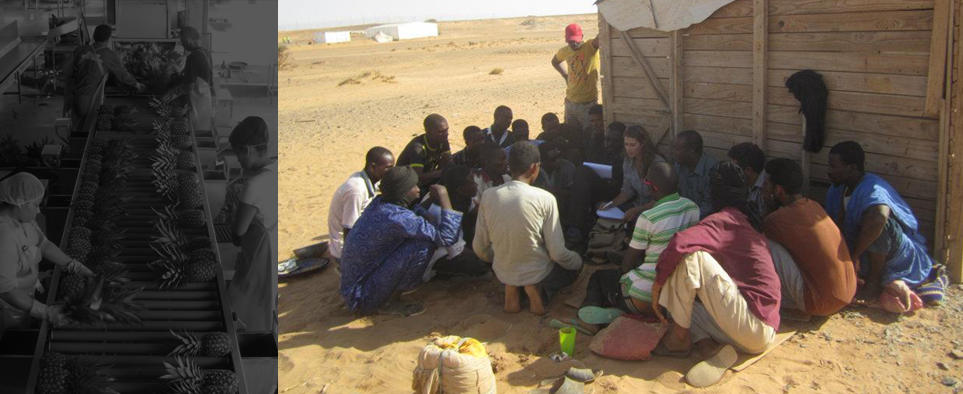- AFL-CIO. 2013. Responsibility Outsourced: Social Audits, Workplace Certification and Twenty Years of Failure to Protect Worker Rights.
ABSTRACT: “The failure of governments to protect workers’ rights in the global economy has left a yawning gap of regulation and helped spawn an $80 billion industry in corporate social responsibility (CSR) and social auditing. Yet the experience of the last two decades of “privatized regulation” of global supply chains has eerie parallels with the financial self-regulation that failed so spectacularly in 2007 and plunged the world into deep and lasting recession. This detailed and extensive report by the AFL-CIO reveals just how bad much of the CSR industry has been for working people. Not only has it helped keep wages low and working conditions poor, it has provided public relations cover for producers whose disregard for health and safety has cost hundreds of lives. The AFL-CIO research underscores the central failing of the CSR model, which is based mainly on short and cursory visits to factories and no proper discussion with workers. This, coupled with the big global brands holding on to the “Walmart” model of driving prices to local producers ever lower and demanding ever-faster production, the dominant social auditing model will never achieve decent, secure jobs for the millions of workers at the sharp end of the global economy.”
- LeBaron G et al (2017) Governing Global Supply Chain Sustainability through the Ethical Audit Regime. Globalizations, DOI: 10.1080/14747731.2017.1304008.
ABSTRACT: “Over the past two decades multinational corporations have been expanding ‘ethical’ audit programs with the stated aim of reducing the risk of sourcing from suppliers with poor practices. A wave of government regulation—such as the California Transparency in Supply Chains Act (2012) and the UK Modern Slavery Act (2015)—has enhanced the legitimacy of auditing as a tool to govern labor and environmental standards in global supply chains, backed by a broad range of civil society actors championing audits as a way of promoting corporate accountability. The growing adoption of auditing as a governance tool is a puzzling trend, given two decades of evidence that audit programs generally fail to detect or correct labor and environmental problems in global supply chains. Drawing on original field research, this article shows that in spite of its growing legitimacy and traction among government and civil society actors, the audit regime continues to respond to and protect industry commercial interests. Conceptually, the article challenges prevailing characterizations of the audit regime as a technical, neutral, and benign tool of supply chain governance, and highlights its embeddedness in struggles over the legitimacy and effectiveness of the industry-led privatization of global governance.”
- O’Rourke D (2014) The Science of Sustainable Supply Chains. Science, 344, 6188: 1124-1127.
ABSTRACT: “Recent advances in the science and technology of global supply chain management offer near-real-time demand-response systems for decision-makers across production networks. Technology is helping propel “fast fashion” and “lean manufacturing,” so that companies are better able to deliver products consumers want most. Yet companies know much less about the environmental and social impacts of their production networks. The failure to measure and manage these impacts can be explained in part by limitations in the science of sustainability measurement, as well as by weaknesses in systems to translate data into information that can be used by decision-makers inside corporations and government agencies. There also remain continued disincentives for firms to measure and pay the full costs of their supply chain impacts. I discuss the current state of monitoring, measuring, and analyzing information related to supply chain sustainability, as well as progress that has been made in translating this information into systems to advance more sustainable practices by corporations and consumers. Better data, decision-support tools, and incentives will be needed to move from simply managing supply chains for costs, compliance, and risk reduction to predicting and preventing unsustainable practices.”
- Sinkovics N, Hoque S, Sinkovics R (2016) Rana Plaza Collapse Aftermath: Are CSR Compliance and Auditing Pressures Effective? Accounting, Auditing and Accountability Journal 29, 4: 617-649.
ABSTRACT: “The purpose of this paper is to investigate the intended and unintended consequences of compliance and auditing pressures in the Bangladeshi garment industry. To explore this issue the authors draw on three medium-sized suppliers. The institutional changes that followed the Rana Plaza accident in April 2013 make Bangladesh in general and the garment industry in particular an interesting and suitable research setting for standards compliance…. The results indicate that the pressure for compliance has led the case companies to prioritise the implementation of measurable standards over the socially grounded needs and priorities of workers. As a consequence certain initiatives instead of adding new social value in fact destroyed previously existing social value. Furthermore, the pressure for compliance created the necessity to find ways to cover the sizable cost of compliance. This prompted firms to pursue process upgrading through technological advancements and increased work pressures on the labour force. These initiatives led to an increased power imbalance and the exclusion of unskilled workers from the job market.
- Short J, Toffel M, Hugill A (2016) Monitoring Global Supply Chains. Strategic Management Journal 37, 9: 1878-1897.
ABSTRACT: “Firms seeking to avoid reputational spillovers that can arise from dangerous, illegal, and unethical behavior at supply chain factories are increasingly relying on private social auditors to provide strategic information about suppliers’ conduct. But little is known about what influences auditors’ ability to identify and report problems. Our analysis of nearly 17,000 supplier audits reveals that auditors report fewer violations when individual auditors have audited the factory before, when audit teams are less experienced or less trained, when audit teams are all-male, and when audits are paid for by the audited supplier. This first comprehensive and systematic analysis of supply chain monitoring identifies previously overlooked transaction costs and suggests strategies to develop governance structures to mitigate reputational risks by reducing information asymmetries in supply chains.”




